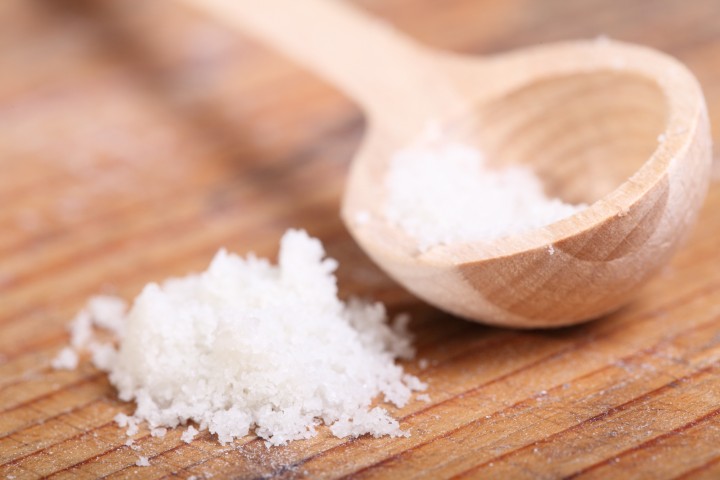
If you want to find out what salt does for your loaf, try and leave it out and take a bite…
Klik hier voor de Nederlandse versie
A while ago we took a closer look at the percentage of salt we put into our bread. If you are a big bread eater, chances are high you get a lot of your daily salt intake via your sandwiches.
The UK recently came out with a new standard for the amount of salt in bread baking. So we tested this new standard to find out what the effect would be for our own bread baking and want to share the result with you…
First, some things you need to know about salt and bread baking:
What does salt do?
- Salt acts as a natural antioxidant in the dough and not only adds taste but especially helps bring out the flavors and aromas present in the flour and other ingredients.
- Next to its role in boosting the flavor of your bread, salt plays a role in tightening the gluten structure and adding strength to your dough. It helps the loaf to hold on to the carbon dioxide gas that is formed during fermentation, supporting good volume.
- Salt slows down fermentation and enzyme activity in dough. The salt crystals draw water away form their environment (salt is ‘hygroscopic’). When salt and yeast compete for water, salt wins and the yeast is slowed down.
- Because of its moisture maintaining properties, salt can prevent bread from getting stale but it can also (this is especially true in humid environments) absorb moisture from the air and leave you with soft crusts and soggy bread.
How much salt is considered normal in bread baking?
In bread baking the percentage of salt added that is considered normal, ranges from 1.8% to 2.2% of the total amount of flour, depending on the recipe and personal preference. Low salt contents can lead to bland loaves, anything over the 2.2% norm will likely be considered too salty. The UK recently came out with a new standard of 1 gram of salt per 100 grams of the final baked bread or about 1.5 to 1.6% of the total amount of flour. So instead of a percentage of salt to flour, they give the amount of salt per 100 gram of the actual finished product / bread.
Should I be afraid of salt touching my yeast?
Short answer: NO! Usually you add salt and yeast to your flour and immediately start mixing. It is totally unnecessary to put salt on one side and yeast on the other and seconds later start mixing them together anyway. You do not want to add salt on top of fresh yeast and leave it for minutes because then the salt will indeed kill the yeast.
What type of salt should I use for bread baking?
All salt is good, as long as the salt crystals are fine enough and dissolve easily. A lot can be said for different types of salt, some contain additives, some have other minerals next to the sodium chloride (NaCl) considered beneficial for you (like Celtic sea salt which is also lower in sodium). You can make up your own mind as far as the health benefits go, taste wise it will not make a big difference to your loaf. Due to the relatively small quantity of salt it would be really hard to detect subtle differences in flavor.
Our own findings with the new salt content standard
So, we looked at our own baking and did a test with this new UK standard of 1 gram salt per 100 grams baked loaf. For example, for a standard pain rustique (750 g dough, weighing about 680 g after baking) this would mean lowering the added salt from 8 g to 6.8 g or from 1.17 g to 1 g per 100 g bread.
Examples of bakers percentages for a loaf of pain rustique:
2.2% of total flour would mean almost 10 g of salt added to the recipe
2% – about 9 g of salt
1.8% – just over 8 g of salt
1.5% – about 6.8 g of salt (the new UK standard)
We tested and tasted the bread with new, lower salt content several times, together with some bread friends. Result: We all had a very hard time noticing any difference. There is a line below which it would become noticeable of course, but this new standard is no problem for us. We have to add that using high quality (organic) flour also makes a big difference in taste and perception of saltiness. Also see our flour experiments. To enhance flavor, salt has to have something to work with, and it will have a hard time bringing out any flavor when the flour you work with is overly processed and bland to begin with!
We now use it in most recipes for our daily bread, except when making dough for things like pizza and focaccia and other flatbreads. For these special breads our personal preference is to make this dough a bit saltier.
Let us know your thoughts on salt!



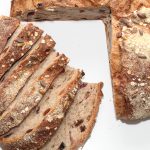

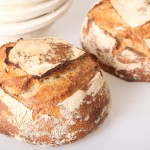
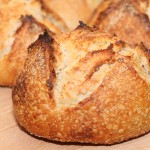
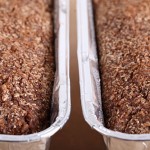

Celeste Harrell says
Thank you I needed this lesson.
Weekend Bakers says
Glad you found it helpful Celeste.
Eric Su says
This article was very useful for me: not for baking, but for my science fair project.
So my question was about the decompose of bread, agents, and preservatives. For my hypothesis, I need some research for which food ingredients are agents and which are preservatives. Luckily, this article existed. (Yay!)
So thanks Weekend Baker – I am not that much of a baker myself, though.
Eric Su says
Well, I live in Brisbane, Australia where the time zone is +10, and this time displayed is in +2, so the time is really off and my time of posting was actually 17:03…
Weekend Bakers says
Thank you Eric, and so good to hear the information was useful to you. Excellent. Hope you get good grades and triumphantly finish your studies.
And maybe, who knows, some day, you will discover the joy of baking your own excellent bread and the science behind that.
And thank you for your remark about the time display. We will try and fix it!
Greetings from Holland,
Ed & Marieke
martin drury says
I use 1 tsp of table salt per 450g of flour for both white and wholemeal flour. I get great results and taste
Weekend Bakers says
Thank you for sharing Martin. For our readers: One teaspoon is about 5.7 grams of salt and 1.26% of the flour weight of 450 grams, so well below the new UK standard.
Sandy says
Thank you for this percentages testing and actual math! I couldn’t understand how much salt is needed and why – i mean I understand the why but not the math behind it so this finally gives my brain a rest! I’m using 1.5% going forward and I’m glad I can create my own recipes now and have a method to the madness. Thanks again!
Weekend Bakers says
Very good to get your enthusiastic feedback on the article Sandy. Baking should be a relaxing and enjoyable activity and we feel we helped a bit toward achieving this. Excellent!
Greetings from the Low Countries,
Marieke & Ed
Mary E. Riley says
Thank you for the Tuscan bread recipe. Some recipes are hard to find.
Weekend Bakers says
Glad we can help 🙂
Sheila says
May question is. On a very low salt diet how little or much salt to use making yeast bread?
Thanks.
Weekend Bakers says
Hello Sheila,
To start it is always a good idea to consult your doctor or dietitian and how much salt percentage wise is allowed in your bread, based on your average bread consumption and of course taking other foods into consideration too. If you bake your own, you can go as low as zero% salt, but if you can have a little bit of salt, in general the bread will be tastier of course. We think, if possible in your situation, you can for example start with a third of the salt given in the recipe and see how that goes. Hope you can find the right balance!
Jean-Charles says
Great article! I have been baking wholemeal sourdough since about 3 years, 3-4kg of bread a week (2kg of flour) and generally use 10g of salt for the full batch. That’s a ratio of roughly .3g added salt per 100g of bread, and that works really well.
You can find more details about the recipe here: swallows-migrate.blogspot.com/2016/…dough.html
Weekend Bakers says
Thank you Jean-Charles for sharing your experience with low sodium baking.
Martin Parsons says
I’ve just tried my first loaf in a bread making machine I was given as misread Tsp as Tbs! So two table spoons of salt went in for a 2lb loaf. It looked quite doughy through the window but hardly rose at all the end result was a nice solid (very ) lump in the bottom of the pan with no “air” in it when I cut it in half. Could this be just the salt in the main or is the moisture wrong too?
Phil says
Too much salt does makes the dough less airy and alters the moisture content as salt absorbs water.
Weekend Bakers says
Hi Martin,
Phil has answered your question for you splendidly. You used 3 times as much salt as needed and our main concern would also be that it is not particularly good for your health, plus we would think it is way too salt to be tasty too. Plus for your 2 lb loaf we would use less than 2 tsps, closer to 1.5 would be our advice. Hope you will give it another try.
Ed & Marieke
Weekend Bakers
Ashley Enochs says
My partner was recently put on a severely restricted diet due to health problems. He must remain below 1600 mg of sodium/day.
Have you baked using any of the low sodium salt substitutes, which swap out a portion of the NACl with potassium chloride? Examples would be LoSalt (UK) or Morton’s Lite Salt (US)? I have been looking into it, and it seems that in some uses, the bitter/metallic taste it can impart is mitigated.
Thank you for your help!
Weekend Bakers says
Hello Ashley,
Sorry about your partners health problems. We do not have any experience with low sodium substitutes or the way it behaves /tastes after the bread is baked. Hopefully somebody else can shine a light on this matter for you.
In the meantime why not bake a bread with a very low salt content, maybe add some spices to make it more interesting if needed, and see how it goes. Maybe also consult your doctor to learn if the LoSalt would be a good option in your partner’s case.
Good luck with everything!
Marieke
Libby says
Hi Ashley,
I have chronic kidney disease and am on a severley restricted sodium diet. My nephrologist told me _not_ to use the salt substitutes because, for me, they’re kidney killers. You might want to check with your Dr. to see if they’re safe for your partner.
Phil says
I just made a really good pizza without salt using caputo 00 and organic king arthur’s all purpose flour. Used about a 60/40 mix. Large for 18 minutes. Less airy than with salt but you get to shorten the rise time at least. 🙂 Add extra flour on the outside if it starts to tear due to the lack of salt and you will be good to go. 🙂
Avril Monks says
Our organic bread made with the bread machine is now just about right, having experimented around the menu given in the book. however, it has rather too hard a crust, even baked on the ‘light’ crust setting.
I seem to remember reading that the salt content can influence type of crust and am now going to try reducing it.
Presently, we add just over 1 teaspoon salt per 425 grams flour; will determine weight of salt and work out %age.
Having done this, the salt weight we add is 5.8 grams., so this represents only 1.4%, below the values recommended.
Weekend Bakers says
The amount of salt does not seem to be the source of your problem. We do not have much experience with bread machines, however as the ‘oven’ in the bread machine heats up while baking with the bread already in the machine, this perhaps dries out the outside of the crust too much. In regular ovens, you put the bread in the oven when it is fully heated and you can use steam to create a nice crust. Having said this, somebody with more experience with bread machines can probably give better advice then we can. Happy baking!
Phil says
He is right, I can make soft and crisp crust with 0 salt. The secret is to use finely milled flour. Try red bag caputo 00. It is what they use in Italy. If you use it straight you will need hla real pizza oven so mix it with king arthur organic all purpose flour. My fav so far is 60/40 and it cooked well at 10k’ altitude (18 min best there). For your altitude you will probably need to adjust hotter and maybe slightly shorter time. Stay by the oven and if it starts smoking pull it out and it should be ok and then you can shorten it a spec the next time.
Weekend Bakers says
Thank you Phil, for sharing your experience and knowledge!
frank higgins says
I think (?) I left salt out of my simple white bread recipe. It proofed well but
top collapsed in oven. Due lack of salt ?
Weekend Bakers says
Salt will help strengthen the gluten however the effect should not be as big as you describe. We have baked beautiful looking breads (by mistake!) without salt. Most of the time the reason for collapsing in the oven is either lack of gluten or over-proofing.
Phil says
I believe opening the oven while it is baking can also have this effect.
Camila says
a banana bread yesterday that called for 1/2 a teaspoon of salt and I used half a tablespoon. Is it edibl
Weekend Bakers says
How much flour did you use for this recipe?
Camila says
I used 1 and 3/4 cups of flour. Thanks so much for your help by the way!
Weekend Bakers says
Hi Camila,
Again very sorry to say so, but you used a lot of salt. For a bread around 2% is considered the high end of normal and you used almost twice this amount. You can probably taste it is very, very salty and for something like banana bread, the sweetness needs even less salt probably to get a nice result. As you can read in the posting above, we are at the lower end of the salt intake, when it comes to baking your own bread, but we think it is best if you just use this as a ‘lesson learned’ (happens to all of us, also the other way around, forgetting the salt) and start with a fresh loaf.
Good luck with it!
Marieke
Camila says
Thank you Marieke! Will do!
Phil says
Also too much salt is not good for you. Very dehydrating.
“1500 mg of sodium amounts to 0.75 teaspoons or 3.75 grams of salt per day, while 2300 mg amounts to one teaspoon or 6 grams of salt per day. Most people today are eating much more than that. The average intake of sodium is about 3400 mg, most of it coming from processed foods.” Compliments of Healthline. 🙂
Camila says
Hi there!
I made the mistake yesterday of using tablespoons instead of teaspoons of salt in my french baguette recipe. It called for 2 teaspoons of sea salt and I put 2 tablespoons…. -_- the dough has been rising in the fridge for 4 hours now (out of 11 1/2 hours). What do I do? Should I do something?
Thanks, Camila
Weekend Bakers says
Hello Camila,
We are sorry but there is nothing you can do. The bread contains too much salt for it to be edible and healthy, about three times as much. You can have a taste and judge for yourself, but we think it would be best to start over. This much salt can also have an effect on the proofing of the dough possibly.
Camila says
ok thanks 🙁
Paul says
Why not take the whole dough out of the fridge and add more flour and water, calculating the amounts you need to add to “dilute” the salt to tolerable levels? The dough you already have might even act as a sort of pre ferment. Otherwise, you could always add more yeast as well.
Of course, you’ll end up with way more bread than intended, but you could try saving the over-produce for another time. It works fine for me to freeze baked or par-baked loafs, and thaw and stick them back in the oven for 10- 15 minutes when I want more of my bread.
You might yet be able to save the oversalted dough… Or did I miss something there?
Cheers
The
Weekend Bakers says
Thanks very much for adding your suggestion and advice Paul. The only thing we would add that, in this case, you will end up with three times the amount of dough and this means you must have the capacity with your mixer and also oven to process these quantities.
ELLIE says
I HAVE CKD (CHRONIC KIDNEY DISEASE) AND I HAVE TO LIMIT MY SALT INTAKE AND I NEED TO KNOW IF SALT IS REALLY, REALLY NECESSARY IN HOME BAKED BREAK.
Weekend Bakers says
Hello Ellie,
No it is not necessary. We once made our baguettes and forgot the salt and only discovered it after tasting and to be honest we did not see much difference at first glance. Most famous for bread without salt are the bakers from Tuscany, and it might be a good place to start, because these people know the how and why of saltless baking. You can find more information and a recipe here:
www.wildyeastblog.com/saltl…can-bread/
Good luck with everything!
Joanne Matheson says
Hi Ellie, I stopped putting salt in my bread maker loaves over two years ago, to help reduce family salt intake, and they are always fine. I think they taste nicer and the rest of the family didn’t even notice! I sometimes add some fresh parmesan for a change, which gives a slightly salty flavour. Good luck.
Libby says
Hi,
I followed this link
www.wildyeastblog.com/saltl…can-bread/
Only to discover it no longer exists, and I was sorry to see because I also have chronic kidney disease and am extremely sensitive to salt.
I do thank you for the info on not adding any salt to bread, I was under the impression it was necessary. Now it looks like bread may be back in my future.
Weekend Bakers says
Hi Libby,
I checked and found this page: www.wildyeastblog.com/saltl…can-bread/
It should work…
Hope you can try a saltless loaf and it will be something you can enjoy!
Mary Jean Watson says
My husband and I are on a low-salt diet and wish to use the least amount of salt possible on making bread and pizza dough in a bread machine. Do you have any other suggestions?
Weekend Bakers says
Hello Mary Jean,
As you can read in the article 1.5% would be a good lower amount to start with, compared with the bread you buy, but it will be no problem (also for the baking result) to lower this to half the amount or even further down to no salt at all. In the end it is a sum of how much salt you take in in total through your food during the day and what amount your doctor tells you is the right amount for you. Next to that there is the taste factor and finding the right balance between low-salt and still a tasty pizza and bread.
Tarek mesbah says
Thank you very much for this important details
Tarek mesbah says
Please answer me why gluten broken dwon after long fermantation
Weekend Bakers says
It has to do with bacteria and yeast that chew up the gluten (break them up in smaller pieces). You can read the whole story in our post about gluten :
www.weekendbakery.com/posts…ut-gluten/
Tarek mesbah says
Thankful for the perfect answer
Jim says
Thanks for sharing.. I love bread! I’m new to baking yeast breads. And, I’m on a low salt and sugar diet.
Your article answered my question of whether salt was truly required for baking and, if so, what was the minimum necessary amount
Weekend Bakers says
Thank you Jim for your comment and for finding it useful.
Happy low salt baking!
rosemary says
I make a lot of banana bread I must watch my sodium intake what is the least amount of salt I can put in a recipe ?
Weekend Bakers says
Hi Rosemary,
You can put any amount of salt in it you like, even no salt. This will have a slight effect on the baking result and taste of course, but it will still be good. You can also test it by gradually adding less and see what version you like best. Plus you can add spices and herbs to add flavor.
Good luck with it and happy baking!
Hubene Brodie says
Is the amount of sodium that is listed on the bread wrapper the actual salt added to the bread or does it also include both actual salt added and the amount that is included in the flour?
Weekend Bakers says
Hi Hubene,
Naturally, flour contains some sodium (between 2 and 6 mg per 100 grams), so a tiny amount compared to the amount that is added to the flour to produce the bread. So it would not make a big difference if the bread contains 8 grams salt or 8,006 grams. Normally the amounts on a wrapper are rounded.
John Winters says
320 g organic whole wheat flour
5 g Atlantic Sea salt unrefined
5 g yeast
Weekend Bakers says
To what or what recipe does this refer to John?
John says
Most people making bread use cups and spoons not grams making this useless to me.
Weekend Bakers says
Hello John
To help you with conversion of salt
1/4 teaspoon 1.42 grams
1/2 teaspoon 2.84 grams
1 teaspoon 5.69 grams
1/2 tablespoon 8.53 grams
1 tablespoon 17.07 grams
Our advice:
We very much recommend weighing your ingredients. Professional bakers use scales and in Europe all home bakers do too. A scale will give you the exact same weight every time. Which is absolutely needed if you consistently want to make good bread and especially good pastry.
grahame says
no we don,t thx, a european home baker, never weigh anything don,t assume
Phil says
It’s more fun to not measure and you probably will learn a lot more. It may take you longer to get it right but you will be able to go by using your senses, which will help you to be able to add variety to your recipes and know how each change effects the process. 🙂 That and it is faster and looks sweet not having to use a recipe. That being said, it is good to look at recipes too and try those, that way you can learn a few things from other peoples experience as well. Study how to bake different breads and you can learn lots of tricks that you can mix between the bread types.
John Winters says
Such measures are not professional.
Kathrin says
I was wondering what would happen to the gluten produced as more and more salt was added. Thank you for taking your time to answer my question xx
Weekend Bakers says
Hi Kathrin,
Other than it becoming inedible we are not entirely sure what the overall effect would be, certainly not based on experience. We found an interesting article that gives more background to your question and also shows how much is still unknown on a molecular level when it comes to this subject: cargillsaltinperspective.com/salt-…ead-dough/
Kathrin says
thankyou so much for the help.
Marie-Louise Parker says
What type of bread recipe can I make without salt as I am not allowed salt at all.
Weekend Bakers says
Hello Marie-Louise,
In principal you can make all kinds of recipes. We once made our baguettes and forgot the salt and only discovered it after tasting and to be honest we did not see much difference at first glance. Most famous for bread without salt are the bakers from Tuscany, and it might be a good place to start, because these people know the how and why of saltless baking. You can find more information and a recipe here:
www.wildyeastblog.com/saltl…can-bread/
Happy baking!
Benn says
What would adding to much salt do?
Weekend Bakers says
Hi Benn,
Salt slows down fermentation and enzyme activity in dough. The salt crystals draw water away form their environment (salt is ‘hygroscopic’). When salt and yeast compete for water, salt wins and the yeast is slowed down. So too much salt will not only make your bread less edible or even inedible but way too much will eventually have a negative effect on the development of the bread. Normally you would never use that much salt, so the only negative is that too much salt is not that good for your health and will also mask other good flavors in your bread. In short, you always need to find the right balance.
Rob Graham says
I’m answering aquestion of what happens whenyou have too much salt. I am now a widower and am using my wife’s breadmaker with wholemeal flour. The bake is quite long so I make one mix and chuck it in, start the machine and make up the fluids and dries for the second mix. I now have both forgotten the salt and put in double. Double and it tastes nasty and doesn’t the rise is partially inhibited – missed the salt and apart from tasting a bit bland (wholemeal helps here), the texture is not so tight – more flakey – and the loaf rises too far too early and then to top collapses. In line with the discussion here, I will try reducing the salt from 2 to 1.5 tsp in a 700gm loaf.
I will have a little dig here and ask when, oh when will the US come in line with the rest of the world and use the so-much-more sensible metric measurement system – I work in wood and find US designs calling for 1/32nd and 1/64th of an inch; just how archaic can you get? And as for ‘cups’!!!
Weekend Bakers says
Hi Rob,
We really enjoyed reading your comment. First of all thank you for sharing your insight and experience on the too much or not at all use of salt in bread baking. And second because of your remark on the use of the metric system. Your example speaks volumes of course!
We are very sorry for your loss and admire you for taking up the bread making after your wife’s passing and hope you find great joy and comfort in baking and eating your home made bread.
We find, if you gradually decrease the salt and use good quality flour, you will very probably find you can have a real tasty loaf with less.
Greetings from Holland,
Ed & Marieke
Jane Owen Schaumloffel says
Thanks for clarifying the “salt question” for me. I’m new to bread making and want to learn. Today I baked a loaf (half white/half brown) with no salt added. It is rather crumbly plus slightly bland although pleasant enough since it’ll be eaten with salted butter.
Weekend Bakers says
Hi Jane,
Glad you find it useful. When you mention the crumbly texture, and would like it less so, you probably need to develop the dough (gluten) more, so either extent the kneading or develop the dough with other techniques like stretching and folding like in one of our favorite recipes the ‘pain rustique’ : www.weekendbakery.com/posts…-rustique/
And if you are able to eat salt it is a good idea to add at least the minimum to your bread recipe, because it does enhance flavor and has other advantages.
Happy baking!
Tom says
So how much salt should we add to our regular Sandwich bread? And with what? I found that for taste, sugar and salt are good combination if the ratio is right. I am still experiencing it. I hope you can tell a bit more on these.
Weekend Bakers says
Hi Tom,
We can only advice what we would do ourselves for a sandwich bread. We would go for around 1.6% salt or 8 grams for a 500 g flour loaf. You can try it or else go up a bit to 1.8%. When adding sugar or honey to a sandwich loaf we would recommend using between 10 and 20 grams and no more, again for a loaf based on 500 g flour.
Peter says
How is table salt an antioxdant?
Weekend Bakers says
Hi Peter,
The type of antioxidant working this refers to is the effect the salt has on the flour and the gluten. So we are not referring to the antioxidants like vitamin C related to food and health. It has to do with structure and elasticity in dough.
Deb says
Hi
I wondered if you’ve tried replacing some salt with seaweed? I add seaweed but not sure n percentages etc or type e.g Kimble, Dulles.
I make around 1500g dough and add 11g salt 5g seaweed.
Weekend Bakers says
Hello Deb,
Thank you for this suggestion. We do not yet have any experience with seaweed but it will be a good tip for many people and seaweed is a healthy food. Of course you have to take into account that seaweed also contains NaCl. So not sure what this means for people who need a low sodium diet. Guess as for the percentage it is again something you have to experiment with and adapt to your own taste and needs.
David Hey says
In my sourdough I use 1% salt to the flour weight. Tastes fine. If you are used to eating high volumes of salt then you would I initially have a taste problem. About to reduce to 0.5% to see if the structure holds.
Suffering with high blood pressure need to keep salt to a minimum.
Zdenka says
We do not like “too” salty in my family even if nobody has a problem with high blood pressure. For my friends I use 1% salt and nobody ever complained about it. Even if for some it was a matter of habit and now they much more appreciate the less salty bread. You always take something salty or sweet with bread anyway 😉 For me it’s too much so I use 0,5% salt in breads and rolls for me (and often my family). It holds the structure perfectly fine.
Weekend Bakers says
Exactly our experience too
Imogen says
I recently made a wholemeal loaf with no salt at all and unsalted butter. The loaf tasted like bread I remember from my youth….I found it very morish! I noticed however that the crumb was loose and slices broke down when given a slaver of spread. I suspect what I’ll do is add the tiniest amount of salt until these last two ‘defects’ are solved and no more. (The solution might even be to use salted butter and no other added salt???)
Weekend Bakers says
Hello Imogen,
It is very much possible to make a loaf without salt that has a different structure to what you describe. It depends on the recipe and the method you use. You can also look into the flour you use, the protein content of the flour and the intensity and duration of kneading to get a good structure. The loose crumb can very well be the result of not enough gluten development / not enough kneading.
Hope this helps.
Annabel says
I too am baking for a family member with very restricted sodium requirements. Rule of thumb: 1g of salt = 400mg of sodium. When someone is allowed less than 2000mg sodium per day, bread becomes a yearned-for indulgence instead of “the daily bread”… e.g., the ficelles with sourdough have 800mg sodium EACH, which is nearly half of their entire daily allowance.
I have found that halving the salt in most bread recipes produces bread that falls within low-sodium guidelines, but it is noticeably bland for the rest of us. I don’t find it practical to make two batches of dough just so one can have salt and one not. Here are a couple of ideas for non-dieters eating low-salt bread:
– Buy a good salted butter and slather it on the low-salt loaf–this will add back the savor we non-dieters are missing! Or you could use EVOO seasoned with fresh ground black pepper and sea salt for dipping. *Good for slender loaves such as baguette/ficelle. Works with croissants too, though buttering a croissant is gilding the lily…
– You could also make a low-salt version of a recipe that yields multiple loaves, and then incorporate a salty addition (such as olives or chopped ham or a salty cheese) to some of them. *Good for boules and heartier breads that can stand up to additions.
The low-sodium diet is a lot of work–I’m happy to be able to bake fresh bread that can fit into such a plan.
Weekend Bakers says
Hi Annabel,
Such great tips to , thank you for sharing! These will inspire lots of people with the same challenges. The salty addition is inspired too. Plus, even the blander home made loaves will be so much better than anything low sodium store bought. And like we say, the flour you use can make a big difference in taste to, so no bland processes flour to begin with but good (organic stone ground) stuff that still has the memory in it of the plant it once was.
Enjoy the baking!
Aditu Iseoluwa. says
Actually I observes it recently that some bread loaf i bought for consumption were too salty. As a result of this i could not enjoy the taste of the bread. May be others are enjoying it i could not know, but i’m thinking of confronting baker of too much salt in breads they baked for public consumption.
Please what do you advise.
Thanks.
Br.,
Aditu.
Weekend Bakers says
Hello Aditu,
It depends a bit on what the guidelines in your country are and if the baker is complying with them. But you could have a friendly conversation about it and ask your baker about it. Bakers can make mistakes too of course, maybe something went wrong if it really was too salty.
Enjoy your weekend.
Greetings,
Ed & Marieke
Ferdinand Smith says
Thanks for clearly explaining the roles salt plays in the bread making process. I have been baking different breads with some success. With this info, I believe I can fine tune things,thanks a lot.
Weekend Bakers says
Hi Ferdinand,
Glad it is useful to you. It’s a thing you can immediately incorporate in your bread baking and play around with, to find the right amount for your taste and needs.
Jim H. says
Thank you. I am on a low-to-no salt diet and I enjoy baking and eating my bread experiments.
Weekend Bakers says
Hi Jim,
So great to be able to bake your own and decide what goes in it!
Happy baking and eating
Linda Partin says
My husband has congestive heart failure and needs to restrict his sodium intake to 2 grams per day. I was surprised at how much sodium store brought bread has, I thought I make my own. The recipe I have for basic bread is one teaspoon to three cups flour. Can I lower the amount of salt and still have good bread.
As a child, my mother worked outside the home. Every Saturday was bread and noodle making day; with dough left in the refrigerator for fresh dinner rolls during the week. So I know it really doesn’t take much time to make the bread.
Weekend Bakers says
Hi Linda,
Sorry to hear this. Yes you can reduce the salt and still get a good loaf, no problem. You can get slight differences because of the effects described above, but the main one is the taste of course. We would suggest using 3/4 tsp and see how that goes and you can also use herbs and spices to make the taste more interesting of course. In Italy, in Tuscany, because of historic reasons, they do not use any salt in their bread. The funny thing is you can get used to it after a while. But we do prefer a version with salt, although we use less in our bread and food than most people around us.
Wonderful story about how bread and baking has always been central in your life.
Happy baking!